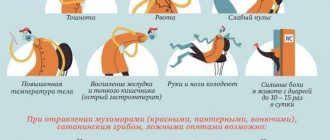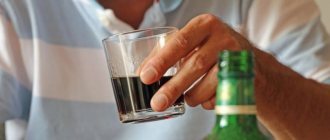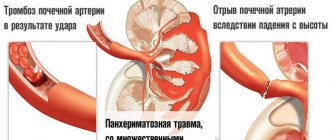Intoxication of the body is a general concept that characterizes poisoning with psychoactive and other substances. It implies a whole range of symptoms that develop against the background of poisoning. Intoxication can be determined both by external manifestations and symptoms, and by laboratory tests in some cases.
According to the WHO, “the term is most often used in relation to alcohol consumption - its equivalent in everyday speech is “intoxication”” (https://www.who.int/substance_abuse/terminology/acute_intox/ru/). However, it is important to understand that such a diagnosis can only be the main one in cases where poisoning is not associated with other disorders caused by the use of alcohol or psychoactive substances. In other words, the symptoms of one-time alcohol poisoning or accidental ingestion of toxic substances can be called intoxication. With constant intentional use, we will be talking about a dependence syndrome or a psychotic disorder.
There are many toxic components and types of intoxication that are not associated with drinking alcoholic beverages. Therefore, a classification was developed that determines the route of entry of harmful substances into the body and the mechanisms of development of poisoning.
Causes of food poisoning
One of the world's "high-profile" cases of food poisoning: In Germany in 2011, about 4,000 people were hospitalized as a result of mass poisoning, 53 of whom did not survive. It took several months to trace the source of the infection. As a result of numerous studies, the cause of the outbreak of food poisoning was established - it turned out to be fenugreek seeds imported from Egypt, the sprouts of which are used as a seasoning for dishes. Food poisoning is common. The peak incidence occurs in the warm season. Food poisoning in an adult is provoked (symptoms and treatment will be discussed below) by various microbes and bacteria, the toxins they secrete and their metabolic products (exo- and endotoxins), as well as non-microbial poisoning (toxic products).
Poisoning with ethanol and its surrogates
According to the World Health Organization, more than 300 thousand people die annually from intoxication with alcohol and its substitutes.
According to the international classification (ICD10), the toxic effects of alcohol are coded as T51.
One of the largest cases of poisoning with surrogate alcohol occurred in the Estonian city of Pärnu in 2001: workers at one of the plants stole 20 canisters of methyl alcohol. As a result, 68 people died from poisoning, and 43 became disabled after intoxication.
Methyl alcohol is a potent poison of the vascular and nervous system. It is quickly absorbed and very slowly eliminated from the body.
Typical results of methanol poisoning are blindness, cerebral edema, and cardiac and respiratory arrest.
The main causes of food poisoning:
• toxic infections – staphylococcal toxicosis and botulism, mycotoxicosis, mixed toxic infections, etc.; • toxic organic and inorganic substances; • violation of food production technology and improper storage, non-compliance with temperature conditions; • contamination, contamination of food with bacteria; • products that have become toxic under the influence of various factors and pesticides, nitrates, herbicides, fungicides accumulated in the peel and core of vegetables, berries and fruits; • unwashed vegetables and fruits, poor food hygiene.
An excellent environment for the growth of bacteria are multi-component salads, brawn and aspic, meat dishes, desserts with a cream base, canned mushrooms and dried fish. If you have even the slightest doubt about the suitability of foods intended for human consumption, it is better to refuse them.
How to relieve alcohol intoxication?
Unfortunately, the morning after a festive “alcoholic evening” is not always good. My head is pounding, my mouth feels like the Sahara Desert, my heart is pounding somewhere in my throat, it’s cloudy and stormy, a cat is loudly stomping around the apartment - a nightmare, in a word!
Mild alcohol intoxication, or, more simply, a hangover, is usually treated at home.
What needs to be done: get enough sleep, take Enterosgel sorbent on an empty stomach, be sure to have breakfast and drink clean water throughout the day.
A drip for alcohol intoxication at home can be prescribed if you need to immediately “get back on track.”
Food poisoning in adults: symptoms and treatment
In adults, the symptoms of food poisoning are mostly short-term, but they are accompanied by a pronounced disruption of the digestive system and quite often lead to general intoxication of the body. Clinical manifestations of pathology that occur several hours (sometimes up to two days) after poisoning include:
• belching with an unpleasant odor; • feeling of heaviness in the stomach; • nausea; • vomiting of food debris, liquid and mucus, sometimes bile; • spasmodic abdominal pain, colic of varying intensity; • diarrhea, sometimes streaked with blood in the stool.
Vomiting and diarrhea are attempts by the human body to independently remove pathogenic substances. The development of intoxication is indicated by pain in the temples, muscles and joints, weakness, and increased body temperature. Untimely treatment of food poisoning increases the likelihood of complications and can lead to dehydration, infectious-toxic shock, sepsis, hypovolemia, etc., even death.
However, there is usually no need for hospitalization for mild cases of the disease and competently provided first aid for food poisoning - you can be treated at home if you know exactly what to take at home in case of poisoning.
Food poisoning refers to diseases of an acute and subacute nature that arise from eating food containing harmful (or toxic) substances of microbial or non-microbial origin (Fig. 1.16). As a rule, food poisoning is not transmitted from a sick person to a healthy person.
Depending on the cause of the disease, food poisoning is divided into two groups: microbial origin and non-microbial origin.
Rice. 1.16. Classification of poisonings
Foodborne toxic infections are diseases associated with the consumption of food products infected with various microorganisms and occurring with symptoms of acute gastroenteritis and intoxication.
The causative agents of food toxic infections can be representatives of E. coli, Proteus vulgaris, enterococci, enterotoxic species of staphylococci, streptococci, spore anaerobes (Cl. perfringens), galsophilus vibrios (Vino parahaemolyticus) and other microorganisms.
Foodborne toxic infections most often occur in group outbreaks, united by one food source. The mechanism of transmission of pathogens is fecal-oral, the main route of spread is food, the transmission factors most often are meat products, less often - milk and dairy products, vegetables.
The main source of staphylococcal infection is a person suffering from pyoderma, panaritium, furunculosis, tonsillitis and other purulent infections. Contamination of products with Proteus, Enterococcus, Clostridia and other microbes occurs due to gross violations of sanitary conditions for the preparation and storage of food and semi-finished products.
In the pathogenesis of foodborne toxic infections, the main role is played by the action of toxins that are produced both in the external environment (in food products) and in the human body. When staphylococcal poisoning occurs, enterotoxin is released, which causes increased motility of the stomach and intestines.
In case of poisoning with toxins produced by Cl. perfringens, alpha toxin is of greatest importance; for poisoning associated with clostridia E - betoxin. In the intestine, toxins cause damage to the mucous membrane, disrupting its absorption function, and when released into the blood, they cause damage to the vascular wall, disrupting its permeability, which leads to the development of severe hemodynamic disturbances. Sometimes the pathogen itself penetrates into the blood, which can lead to the development of severe anaerobic sepsis.
Foodborne salmonellosis . Foodborne salmonellosis is the most severe food poisoning caused by microbes from the Salmonella group. This group includes more than 1,300 species of microorganisms. The causative agents of human foodborne salmonellosis are pathogenic for both humans and animals. In animals, they cause inflammatory processes in the intestines (enteritis in cattle, white diarrhea in chickens, etc.). Diseases arise as a result of the penetration of a large number of microbes into the patient’s body. Once in the intestine, microbes cause an inflammatory process in the wall, while a significant part of the microbes die; when they die, endotoxin is released, which is absorbed through the inflamed mucous membrane and enters the blood. Living microbes also penetrate into the blood. The disease is called toxic infection because the active principle is a toxin (intoxication), and a living microbe is an infection.
Endotoxin, entering the blood, affects the neurovascular centers of the brain. Foodborne toxic infections caused by Proteus and Escherichia coli. Some serological strains of microbes, usually widespread in the environment (Escherichia coli, Proteus vulgaris, Morgan's bacillus, para-intestinal bacillus), under certain conditions that are still poorly understood, acquire toxic properties. By multiplying in abundant quantities on the product and then entering the body, they often cause outbreaks of foodborne diseases.
Salmonellosis is a disease, an intestinal infection, named after the American bacteriologist D. E. Salmon. Bacteria of the genus Salmonella are the causative agents of typhoid fever, typhus and paratyphoid fever. They multiply in the gastrointestinal tract of humans and animals. Certain salmonella can form enterotoxins and cause poisoning.
The causes of most outbreaks of salmonellosis are poor quality food preparation in catering establishments, in domestic conditions, and in food industry enterprises.
The main symptoms of salmonella infection are sudden nausea, vomiting, abdominal pain, and diarrhea. The incubation period can last from 3 to 14 days. The disease may begin with malaise, loss of appetite and headache. Symptoms depend on the form of the disease and may appear gradually and persist for a long time. The severity and duration of the disease depend on the type of salmonella, the amount of food taken, and the body's resistance. Some patients become carriers of salmonella.
Waterfowl eggs (goose, duck) are often contaminated with Salmonella, and their use in the production of confectionery products is prohibited. The sale of such eggs in stores and markets is also prohibited. Chicken eggs (especially the shells) can be contaminated much less frequently. When processing eggs, it is necessary to wash and disinfect them in accordance with accepted instructions.
Dairy products, dried egg powder, etc. can be contaminated with Salmonella. Therefore, constant and careful control over the quality of raw materials supplied to confectionery enterprises is required.
The life activity of microorganisms is influenced by many factors: temperature, moisture, salt, sugar, etc. Most salmonella grow at a temperature of 55... 45 °C.
Salmonellosis diseases can be caused by insufficient cooling of products, improper storage of them in a hot state, the use of contaminated recipe components, and poor cleaning of equipment. It is difficult to recognize the danger of contamination without analyzing the product, since salmonella usually does not change the appearance of the product in which it multiplies.
Salmonella are sensitive to external temperature and are completely killed by prolonged boiling.
Escherichia coli (E. coli) unites more than 100 species of bacteria that are close to each other but have a number of characteristics. The cause of food poisoning is most often E. coli. The detection of E. coli on various environmental objects, as well as in water and food products in sanitary practice is regarded as the result of fecal contamination, and E. coli is a sanitary indicator microorganism. One E. coli is allowed per 333 ml of water and 3 ml of milk.
From some strains of E. coli, medicinal preparations (colibacteria Piratva) are made, which are used to treat putrefactive colitis and chronic dysentery, since some strains of E. coli suppress the growth of putrefactive microflora in the intestines.
The causative agent of foodborne toxic infections is also the putrefactive microbe Proteus (B. Proteus vukgaris), which is widespread in nature. Proteus can infect raw foods and finished products.
Foodborne toxic infections caused by Proteus are usually associated with massive proliferation of Proteus in foods subjected to heat treatment (meat, fish dishes, liver sausage, mashed potatoes, etc.). The optimal temperature for Proteus reproduction is 25-27 °C.
When storing perishable foods and ready-made meals in a warm room in a hot shop, Proteus can develop up to hundreds of millions of microbial cells per 1 g of product, which can result in foodborne illness.
At the same time, the organoleptic properties of the food product do not deteriorate, since Proteus decomposes protein substances not into final substances (indole, skatole, ammonia, hydrogen sulfide), which have an unpleasant odor, but into intermediate substances. Only when Proteus is combined with other putrefactive microbes does deep decomposition of the protein occur until a putrid odor and unpleasant taste appear.
There are known outbreaks of toxic infections, the causative agents of which are representatives of the paratyphoid and dysenteric groups of microbes: Salmonella paratyphoid B, Zone dysentery. These microbes are known to cause infectious diseases in humans. However, under certain conditions, these microbes can multiply on food products, and when such products are consumed quickly, with a short incubation period of several hours, toxic infection occurs.
In cases of toxic infection with the dysentery bacillus, Zona experiences vomiting and diarrhea; after 2-3 days, colitis syndrome occurs with blood and mucus in the stool. It must be taken into account that during outbreaks of toxic infections of this etiology, contact transmission of diseases is possible in the future, i.e. there may be a continuation of the outbreak in the form of an epidemic “tail”, and the place of origin of the disease becomes an epidemiological focus. Therefore, during outbreaks of food toxic infections of dysentery and paratyphoid etiology, it is necessary to carry out a full range of anti-epidemic measures recommended for dysentery and paratyphoid fever. The source of contamination of food products is most often bacteria carriers working at a food plant.
Therefore, the main preventive measure is regular examination of workers at food enterprises for bacteria carriage. If a carrier is detected, the employee should be immediately removed from work related to food processing.
Unlike toxic infections, food intoxications (toxicoses) arise from the ingestion of ready-made toxins released by microbes during growth on the food product into the body with food.
Food intoxications include botulism and staphylococcal toxicosis. Some authors believe that in botulism, in addition to the toxin, a living microbe is also important, and therefore they tend to consider botulism a foodborne toxic infection.
Botulism is an acute disease resulting from the consumption of food containing the toxin Clostridium botulinum. Five types of Cl are known. botulinum - A, B, C, B, E.
All of them cause a disease with the same clinical picture. However, microbes have different antigenic properties, so treatment against each of them can only be carried out with strictly specific serum. Cl has the most pronounced toxic properties. botulinum type A.
Toxin Cl. botulinum is destroyed within a few minutes when boiled, and after 30 minutes when heated to 80 °C.
The botulism microbes themselves are less resistant to high temperatures than toxins. Spores are highly resistant to heat. At 100 °C, spores are destroyed after 5 hours, at 120 °C - after 10-20 minutes. The spores are even more resistant to low temperatures; they do not die even at -253 °C.
Reproduction Cl. botulinum on food products and toxin formation occurs best at a temperature of 20-25 °C.
Staphylococcal intoxication
Food intoxication of staphylococcal etiology is an acute disease resulting from consumption of food containing staphylococcal enterotoxin.
According to the new classification approved by the Ministry of Health of the Russian Federation (compiled by a group of food hygiene specialists - I. A. Karplyuk, I. B. Kuvaeva, K. S. Petrovsky, Yu. I. Pivovarov), food poisoning is divided into three groups based on etiology : microbial poisoning; poisoning of non-microbial nature; poisoning of unknown etiology.
Food toxicosis is a disease that occurs when consuming foods that contain bacterial toxins. This group of diseases includes staphylococcal toxicosis, botulism and mycotoxicosis.
The role of staphylococci in the occurrence of food poisoning was first determined by P. N. Lashchenkov (1901). He isolated staphylococci from cream pies that caused people to become sick.
Among the large group of staphylococci, pathogenic and non-pathogenic are distinguished.
Pathogenic staphylococci from the genus Staphylococcus cause inflammatory processes in the skin, skin tissue, and nasopharynx (sore throat, rhinitis, catarrh of the upper respiratory tract, etc.).
Staphylococci are non-sporeless, facultative anaerobes. Their optimal reproduction occurs at a temperature of 25-37 °C. However, they can reproduce at a temperature of 20-22 °C; at a temperature of 10 °C their growth slows down, and at 4-6 °C it stops.
Staphylococci are resistant to environmental factors. They can withstand temperatures of 70 °C for more than an hour; at 80 °C they die in 20-30 minutes; at the same temperature in a humid environment, staphylococci die in 1-3 minutes. Under favorable conditions, intensive development of staphylococci and toxin formation in a wide variety of products (dairy, meat, fish, vegetables) are possible.
The most favorable environment for the development of staphylococci is milk. This is confirmed by the frequency of intoxications caused by milk and its processed products. At a temperature of 35-37 °C, enterotoxia forms in milk after 5-12 hours, and at room storage temperature (18-20 °C) - after 8-18 hours.
Often the cause of intoxication is cottage cheese and curd products made from unpasteurized milk, rennet cheeses, sour cream, and young cheese.
Meat and meat products are a good environment for the development of staphylococci and the accumulation of enterotoxin. Contamination of meat with staphylococci can occur during the life of animals as a result of inflammatory diseases they have suffered.
Staphylococcal food poisoning can occur when consuming fish products. The taste and smell of canned food inseminated with staphylococcus do not change, bombing is not observed.
Sources of contamination of food products with pathogenic staphylococci are humans and animals. The most common route of contamination of products is airborne, since patients with staphylococcal diseases of the upper respiratory tract (sore throat, rhinitis, pharyngitis) actively release them into the environment when breathing, coughing, sneezing.
People who carry the bacteria are of great epidemiological importance in the spread of staphylococcal foodborne diseases. Pathogenic staphylococcus is found in the nasopharynx of almost every second healthy person. The incubation period for staphylococcal intoxication is usually 2-4 hours. Suddenly, nausea, vomiting, diarrhea, abdominal pain, and weakness appear. Body temperature rarely rises. The duration of the disease is 1-2 days.
Prevention of staphylococcal toxicosis comes down to taking measures to exclude the possibility of pathogens getting into food products and creating conditions that retard the development of staphylococci and the accumulation of enterotoxin in products.
Measures to prevent the contamination of food products with pathogenic staphylococci include timely identification of persons with purulent inflammatory processes of the skin and upper respiratory tract and their removal from working with prepared food. For this purpose, food enterprises conduct inspections of hands and skin. Persons suffering from significant myopia and therefore bending low over food are not allowed to produce cream products, prepared foods, sausages, etc.
A special place in the prevention of toxicosis belongs to measures to improve the sanitary regime of enterprises and compliance with the rules of personal hygiene (especially by persons engaged in the production of finished culinary and cream products), as well as the systematic increase in hygienic knowledge on the prevention of food poisoning. Equally important in the prevention of staphylococcal toxicosis is ensuring a high sanitary level, improvement and mechanization of production processes.
It is extremely important to create conditions that prevent the formation of enterotoxin in food products: store food and finished products in the cold and comply with their sales deadlines.
In recent years, in terms of the number of victims and the frequency of diseases, staphylococcal poisoning has taken a leading place among the entire group of food poisoning.
Staphylococcus pyogenic (Fig. 1.17) is capable of producing various types of toxins: dermatonecrotic toxin, hemolytic toxin, lethal toxin and entsrotoxin.
Rice . 1.17. Staphylococcus
Only those staphylococci that produce enterotoxin in food products pose a danger in terms of food intoxication.
Food poisoning of microbial origin. Three groups can be distinguished.
- Foodborne toxic infections caused by microorganisms that have multiplied on food products and entered the body in large quantities (salmonella, Zone dysentery bacilli, E. coli pathogenic strains, Proteus, Cl. Per fringens, Vas. cereus enterococci, halophilic vibrios).
- Food intoxication caused by toxins of microorganisms formed on food products (pathogenic strains of staphylococci that secrete enterotoxin, Cl. botukinus).
- Mycotoxins caused by toxic waste products of certain microscopic fungi (ergot, fusarium, Aspergillius flavus, etc.).
Mycotoxins arise from the ingestion of waste products from microscopic fungi in food products. The most common and studied of these diseases are fusariotoxicosis, in particular sporotrichellotoxicosis, i.e. diseases caused by waste products of fungi from the genus Fusarium.
Viruses can infect products during processing and storage, if appropriate conditions exist for this. An example of such viruses is the infectious hepatitis virus, etc. In food products, viruses can be inactivated at a low pH value of 3 or slight heat treatment (temperature 65 ° C, duration 1 min). Viruses are also inactivated by radiation and disinfectants such as chlorine and iodine. The virus that causes cholera is resistant to low temperatures and alkalis. They die when heated to 100 °C, as well as when exposed to disinfectants and some acids.
Fungal intoxication. These include mushrooms of the Fusarium series. They attack grain that has overwintered in the field and release toxins. When such grains are processed, toxins are transferred into flour and then into baked flour products. When grain is stored for a long time, toxins are retained.
The food poisoning caused by these fungi is called nutritional-toxic aleukia (formerly known as septic tonsillitis). Another type of poisoning caused by the same mushrooms is called “drunken bread.” This is an acute disease whose symptoms resemble alcohol poisoning.
Flour can cause food poisoning if the grain contains phytonatogenic fungi - ergot and smut. Flour mixed with ergot horns causes severe poisoning - ergotism. Flour mixed with smut, which attacks the grain during germination, has an unpleasant taste and smell. Products made from such flour cause intestinal upset. There is a maximum permissible level for the content of ergot and smut fungi, above which flour cannot be used for food purposes.
Fungi of the species Aspergillus, Mycor, Penicillinum cause molding of flour confectionery products when stored in conditions favorable for their development (temperature 25-35 ° C, relative air humidity 70-80% and product pH 4.5-5.5). Fungal spores present in flour are completely destroyed during baking, but can be released from the environment during cooling, transportation and storage.
On the surface of baked products, mushrooms form fluffy deposits of white, gray, bluish, yellowish and black colors. Fungi multiply very quickly on the product. The formation of mycelium is accompanied by the appearance of an unpleasant, pungent odor. Mycotoxins are formed - toxic substances. Among mycotoxins, aflatoxins have been discovered during development, which are not only toxic, but also carcinogenic to humans. Patulin, which is no less toxic than aflatoxins, was also discovered. Products (bread, muffins, etc.) affected by microscopic fungi are not suitable for food.
Sanitary rules and regulations (SanPiN 2.3.2.560-96) regulate the content of mycotoxins, including aflatoxin, in raw materials used in the production of confectionery products, such as milk, cream, cottage cheese, cow butter, nuts, grain, flour, etc.
Control of flour confectionery products for mycotoxins is carried out based on raw materials. The development of microscopic fungi can be slowed down by freezing products and storing them at a temperature of -24 ° C, under vacuum, in an atmosphere of carbon dioxide or nitrogen. These methods are used in the production of cakes, pastries, muffins, and rolls.
The main measure to prevent molding of products is the necessary sanitary condition of production premises, air, equipment, inventory, the use of sealed packaging of products, disinfection, and compliance with personal hygiene rules.
It is also recommended to bake products so that they are obtained without cracks or breaks in the crust, as well as to cool the finished product faster.
First aid for food poisoning
First aid for food poisoning includes the following therapeutic measures:
• mandatory gastric lavage with warm water (in some cases, vomiting should be induced up to 10 times) - this will speed up the removal of toxins from the gastrointestinal tract before they enter the blood; • urgent use of an effective enterosorbent in the dosage specified by the manufacturer, taking into account body weight and the severity of symptoms - the drug will bind toxins and remove them; • restoration of fluid lost by the body using rehydration solutions; • refusal to eat.
Call emergency services immediately if you have at least one of the following signs: vomiting and diarrhea do not stop, there is blood in the stool, there is no urination or the urine has become dark in color, the body temperature has risen sharply to 38-40 degrees, there is double vision, coordination of movements is impaired , convulsions, excessive salivation or foam at the mouth.
Intoxication of the body when working in hazardous industries
Why did the Mad Hatter from Alice in Wonderland lose his mind? Perhaps it's all in the bag! Or rather, in the processing technology of the felt from which they are made. It turns out that in the 19th century mercury was used to process this material. Chronic intoxication of the body with mercury vapor causes progressive dementia. In England there was even a saying: “mad as a hatter.”
Occupational chronic intoxication these days, unfortunately, is also not uncommon. People who work for a long time in production associated with chemicals gradually accumulate toxic compounds in their bodies. For example, liver intoxication is not so uncommon in chronic lead poisoning.
Symptoms of intoxication in occupational benzene poisoning are associated with toxic effects on hematopoietic organs and blood cells.
Signs of occupational poisoning depend on the toxic substance entering the body.
Common signs of chemical poisoning:
- severe weakness;
- clouding of consciousness;
- dyspnea;
- changes in skin color;
- nausea and vomiting;
- in acute poisoning - loss of consciousness.
Detoxication in such cases is carried out in intensive care units or intensive care units.
Timely intake of Enterosgel sorbent at the first symptoms of intoxication will save you from the dangerous complications of poisoning or reduce its manifestations.
Enterodes - emergency assistance for food poisoning
The drug Enterodes is a sorbent (povidone) that can neutralize the effects of bacteria and toxins, remove them from the body and stop the development of the disease. Experience with the use of this enterosorbent has proven its high effectiveness in food poisoning.
Even a single dose (5 grams per 100 ml of water) can urgently relieve symptoms, reduce their severity and normalize the victim’s condition. The powder form is convenient and easy to use. The action begins within 15-20 minutes. In addition, the drug is completely safe and recommended as first aid for food poisoning.
“Household” intoxication or “reality poisoning”?
It is not for nothing that household poisoning is called the “epidemic of the century”, because quite often the means that are supposed to make our life easier become the cause of acute intoxication. Bleach, pesticides, detergents and cleaners, car windshield wipers - the list of potentially dangerous culprits of severe poisoning is quite extensive.
The number of poisonings due to the erroneous use of household chemicals, especially by children, has increased significantly in recent years. Cases where children's curiosity ends tragically are not so rare in everyday life: either a two-year-old girl swallows a “Mole” for cleaning pipes, or an older boy decides to try a powerful detergent advertised on TV.
After intoxication with household chemicals, acute renal and liver failure occurs. Stopping the work of these vital organs that remove toxins from the body can, in some cases, even lead to the death of a person.
Prevention
To prevent foodborne illnesses, you should follow a few simple rules:
- carry out thorough heat treatment of meat products and mushrooms - consuming them undercooked is extremely dangerous;
- always pay attention to the expiration date of purchased products;
- do not store prepared meat products in the refrigerator for more than 3 days (primarily this applies to jellied meats and pates);
- do not eat mushrooms collected near highways and industrial enterprises;
- do not purchase mushrooms from private individuals;
- do not eat canned food if the lid is swollen or there are even slight traces of rust on it;
- do not drink raw water from the tap or from unfamiliar sources;
- maintain hand hygiene;
- wash fruits and vegetables thoroughly before eating;
- do not purchase food products from unauthorized retail outlets (especially fish, meat, milk and eggs);
- Store all confectionery products with cream only in the refrigerator.
Treatment
Measures to treat intoxication depend primarily on what causes the syndrome. However, the main goal of doctors in this case is to intensify the cleansing of the body from poisons that poison it. Reducing the symptoms of intoxication itself may in some cases be a therapeutic measure that will affect the course of the underlying disease. By cleansing the body of toxins, the manifestations of other diseases may decrease, as well as the risk of complications. All manipulations that doctors carry out during intoxication are aimed at two goals: to normalize the functioning of the main systems and organs, as well as to cleanse the tissues of endotoxins. To maintain the body, medications are administered primarily to protect the liver, normalize the level of minerals, especially potassium, and also to restore the acid-base balance of internal environments. Measures are also being taken to normalize kidney function and improve blood flow.
Classification
The basic classification of food poisoning, adopted in 1981, divides foodborne illnesses into three main groups:
1. Microbial.
2. Non-microbial.
3. Unknown etiology.
The extended version of this classification in various scientific works and textbooks has minor differences, but its essence boils down to the following:
Table 1. Microbial food poisoning
| Variety | Pathogens |
| Toxic infection | Escherichia coli, bacteria of the genus Proteus, Vibrio parahaemoliticus and Vibrio vulnificus, Bacillus cereus, as well as various subspecies of streptococci and clostridia |
| Toxicoses | Staphylococcus aureus, Clostridium botulinum |
| Bacterial | |
| Mycotoxicoses | Fungi of the genus Claviceps purpurea, Aspergillus, Fusarium |
| Phycotoxicoses | Dinoflagellates (marine microalgae) |
| Mixed | Combination of Bacillus cereus or Proteus vulgaris with Staphylococcus aureus |
Table 2. Non-microbial food poisoning
| Product type | Toxic in nature | Toxic under certain conditions |
| Vegetable | Datura, henbane, belladonna, foxglove, elderberry, celandine, any poisonous mushrooms | Sprouted potatoes, almond, peach, apricot, cherry kernels, raw beans, as well as improperly cooked (insufficiently heat-treated) edible mushrooms |
| Animal origin | Milk and caviar of pufferfish, fugu, Sevan chromulus, as well as shellfish and exotic seafood | Caviar and internal organs of some fish species during their spawning (pike, burbot, tench, mackerel), as well as honey, the nectar for which is collected by bees from the flowers of poisonous plants |
| Toxic substances | Agricultural chemicals (pesticides, nitrates), arsenic, polychlorinated biphenyls, heavy metal salts, etc. | |
Documents regulating food safety issues
A regulatory framework has been developed to assist the administration of catering establishments in maintaining food hygiene and ensuring safety. The key documents in it are:
- GOST R 51705.1-2001 (describes the basic principles of food quality management, taking into account the requirements of modern HACCP principles).
- GOST R ISO 22000-2019 (provides the basics of safety management when working with food).
- SP 2.3.6.1079-01 (sanitary rules describing epidemiological requirements for the circulation of products in the catering sector).
In these documents you can find not only information about the requirements, but also justification for them. For example, the condition of using only professional equipment and surfaces is determined by their performance characteristics. In particular, products made of stainless food steel allow the use of concentrated detergents that meet the requirements of public catering to maintain hygiene.











